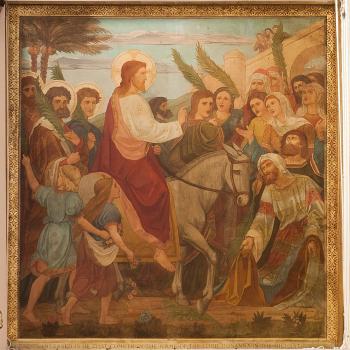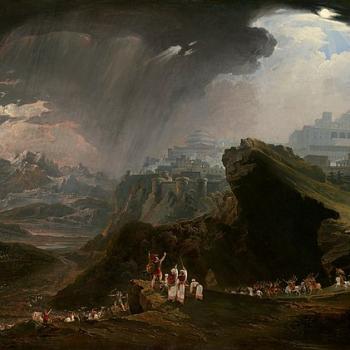Howard Means’s new biography of John Chapman (aka Johnny Appleseed) has been garnering some publicity since its publication on April 12, including generally favourable reviews in the Wall Street Journal and the Boston Globe, and an interview with the author on NPR’s “All Things Considered.” The reviews all discuss the book’s focus on John Chapman’s Swedenborgianism as the driving force behind his itinerant lifestyle.
Means calls Chapman “the New Church’s most famous North American disciple.” That’s disputable: Helen Keller was a New Church disciple (I plan on reviewing her essay “How I Would Help the World,” originally part the introduction for an edition of Swedenborg’s True Christian Religion, and published earlier this month by the Swedenborg Foundation as a standalone book). A search for her name results in more than triple the number of hits for “Johnny Appleseed.” But Chapman was probably the more ardent evangelist of the two, and his Swedenborgianism may be more widely known.
Before getting around to the New Church content, a few thoughts on the book as a whole. According to Means, there are scant trustworthy historical records when it comes to who John Chapman really was. We have stories and legends, as well as transaction records of his land dealings, but few reliable first-hand accounts exist. This probably helps explain why a large portion of the book discusses life in the frontier and the lives of Chapman’s contemporaries rather than focusing on Chapman himself. Although some of these forays seem awfully tangential – there are nearly five pages devoted to the story of Benjamin Thompson, Jr., whose only connection to Chapman is that he was first cousin to Chapman’s mother Elizabeth – they do provide a good picture of the kind of world that Chapman inhabited. It was a remarkably violent world, in which people routinely lost body parts in barroom brawls, and the picture makes Chapman’s gentleness all the more remarkable.
The best parts of the book focus on the way that John Chapman the man became Johnny Appleseed the legend – something that began to take place almost as soon as Chapman arrived in Warren, PA, in 1797. Over the years, John Chapman became John Appleseed and finally Johnny Appleseed, and his legend continued to develop in the years after his death in 1845, from his first appearance on the national scene in a Harper’s Magazine article in 1871, to the 1948 Disney animated adaptation of his story, through various incarnations as environmentalist, pacifist, and even economist. The real John Chapman seems mostly lost in the legend – but that seems to have been true even in his own time.
What is certain about John Chapman was his devotion to spreading the Writings of Emanuel Swedenborg. Along with his apple seeds, he spread chapters from the Heavenly Doctrines wherever he went, famously declaring them to be “good news fresh from heaven.” Means writes,
Apples certainly made Chapman famous. They gave him his nickname and committed him to American folklore and mythology. But what animated him, what gave his mind and actions depth and texture, was a dead Swedish metallurgist-turned-mystic and would-be holy man named Emanuel Swedenborg.
The phrase “would-be holy man” makes me cringe – Swedenborg would have been the first to confess that he was not holy – but the gist of the statement is right: the driving force behind Chapman’s wanderings seems to have been a dedication to spreading the New Church.
To understand Chapman, you have to understand Swedenborg. And while Means gets a lot of things right in his presentation of New Church teachings, there are a few errors – some minor, and a few major. This is not too surprising – he relies on second- and third- hand accounts of people who were children when Chapman visited their families, and even their parents whom Chapman visited probably didn’t understand a lot of the religious talk that came from Johnny. Means does get a lot of things right. His description of the New Church concepts of heaven and hell (found on pages 107-108) is accurate: they are both real places, and we make our home in one or the other based on what we love and how we live.
But there are a few points of doctrine that Means doesn’t get quite right. On page 121, he writes, “Swedenborg dismissed the Holy Ghost, denied the trinity…” He does go on to state more correctly that Swedenborg did not deny a trinity, but contended that the trinity existed in one Person, Jesus Christ. The statement about the Holy Ghost is puzzling – while Swedenborg denies that the Holy Spirit is a separate person of God, he does not deny that the Holy Spirit exists and is active. Rather than being a separate person, the Holy Spirit is God’s influence and activity.
The bigger errors come in a misunderstanding of the New Church view of asceticism and of marriage. Means quotes Chapman’s Fort Wayne Sentinel obituary:
He was a follower of Swedenbourgh [sic], and devoutly believed that the more he endured in this world the less he would have to suffer and the greater would be his happiness hereafter.
If Chapman did believe that earthly suffering was earning him eternal happiness, he didn’t get that idea from Swedenborg. Arcana Coelestia 1947 discusses the meaning of Psalm 15, which discusses the good man as swearing to “afflict himself”:
“Affliction” does not mean that we should plunge ourselves into poverty and wretchedness, or that we should renounce all bodily delights, for in this way evil is not mastered and subjugated; and moreover some other evil may be aroused, namely, a sense of merit on account of the renunciation; and besides, man’s freedom suffers, in which alone, as in ground, the good and truth of faith can be inseminated.
If Chapman was as devoted to Swedenborg as he seemed to have been, he would have been well aware of this teaching. He would have hated the idea that he was “meriting” heaven by making himself miserable. Means is probably much closer to the truth when he speculates that perhaps Chapman was emulating the people of the Most Ancient Church, the golden age that was represented by Adam and Eve in the garden of Eden. The people of that age lived in harmony with nature, and they saw the presence of God’s life in everything. In all likelihood, Chapman was not living in the wild in order to suffer – he was living in the wild because in some ways, that’s where he could see heaven on earth.
And yet Means writes, in relating a story of Chapman dismissing a Universalist (i.e. all are saved) tract, “He hadn’t denied himself the pleasures of children or the joys of the flesh in this world for that!” The implication, it seems, is that Chapman’s Swedenborgianism not only led him to some idea of meritorious suffering, but also to a life of celibacy.
And it’s here – and in other areas related to marriage – that Means shows the biggest misunderstanding of New Church doctrine. Abstinence until marriage is considered a virtue in the New Church, but complete celibacy – i.e. never marrying – is not. True, Swedenborg himself never married, and there’s certainly no sin in that. But neither is it virtuous. Conjugial Love (or Married Love) states in no uncertain terms, “The state of marriage is to be preferred to a state of celibacy” (156). While it may be true that Chapman told people he stayed with that he had a future wife waiting for him in heaven, this is just as likely to have been an expression of Chapman’s trust that eventually he would be married – whether in this world or in the next – as it was to have been the result of some sort of prophetic vision compelling him to avoid marriage in this world.
What Chapman almost certainly did not tell any of his hosts was that he had two virgins waiting for him in the spirit world whom he would marry. If he did say this, it directly contradicted everything in the doctrines that he risked his life to promote. And yet Means reports this as equally plausible to the stories of Chapman telling his listeners that he would marry one girl. Means writes,
Like Swedenborg (or as Swedenborg was understood), Chapman was in frequent “spiritual intercourse” with departed spirits – in Chapman’s instance, two spirits of “the female gender, who consoled him with the news that they were to be his wives in the future state, should he keep himself from all entangling alliances in this.”
First of all – and I don’t think Means intended this – it should be noted that Swedenborg’s “spiritual intercourse” has nothing to do with sexual intercourse – it simply means “interaction,” and modern translators have it as such. In any case, it’s unfortunate that Means relates this story of Chapman’s “future wives” without any comment on how repugnant this idea would be to a Swedenborgian. An entire chapter of Conjugial Love is devoted to explaining why polygamy is sinful and why true marriage can only exist between one man and one woman. In the chapter of Heaven and Hell on marriages in heaven, Swedenborg writes,
The angels declare that marrying several wives is wholly contrary to Divine order, and that they know this from several reasons, one of which is that as soon as they think of marriage with more than one they are alienated from internal blessedness and heavenly happiness, and become like drunken men, because good is separated from its truth in them. (HH 379)
The story of Chapman expecting to marry two wives, then, is extremely suspect, and the repeated reference to it mars the book.
But these errors are not original with Means – he repeats them from the various stories and legends that sprung up around Chapman. And they are in fact a good illustration of one of Means’s main points: that it is difficult to separate the stories and legends from the man himself. I do wish Means had run his manuscript by someone more familiar with New Church teachings – a few of the more blatant errors could have been caught. And for myself I wish he’d done less to paint Swedenborgianism as one more eccentricity, as a religion of the past (one particularly cringe-inducing passage reads, “Of all the survivors [of the religious upheavals on the frontier], almost none is more obscure today, yet more representative of nearly everything that was going on in those early decades of the nineteenth century, than the Church of the New Jerusalem”). Still, the book in the main does succeed in doing what it sets out to do: providing an entertaining and engaging look at the (often distant) relationship between the real-life John Chapman and the legendary Johnny Appleseed.











